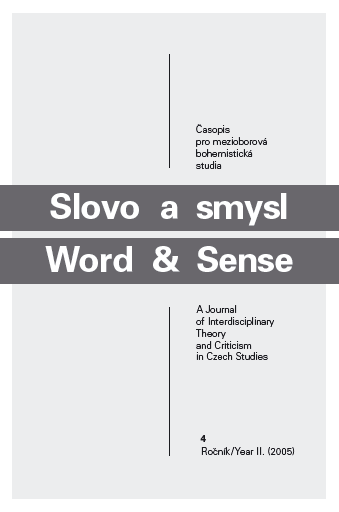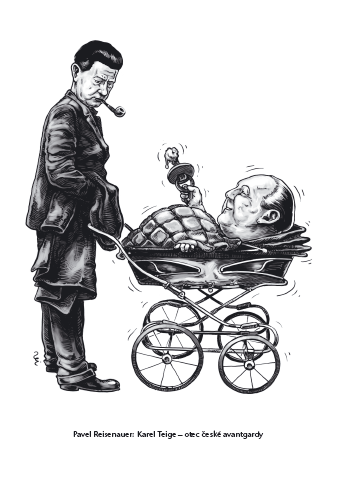Editorial
One must be absolutely modern.
(Arthur Rimbaud, A Season in Hell, 1873)
Faith in a political utopia on the right or on the left,
from Bolshevism to Nazism, which the artistic avant-garde not only shared,
but to which it contributed and dedicated a number of major works,
has disappeared. Since then avant-garde aesthetics has been hanging in the air.
It must therefore all the more fanatically and intolerantly preach to the void.
(Jean Clair, The Reponsibility of the Artist, 1997)
The collapse of the totalitarian system of “real socialism” in the countries of central and eastern Europe has initiated a new phase in the reception and discussion of the legacy and significance of the avant-garde. The development of this reception in the course of the last fifteen years is interesting and significant in many ways: after 1989, the avant-garde was euphorically rediscovered and rehabilitated, and, after four decades (with the exception of a brief period in the sixties) of falsification and defamation on the one hand, and mystification and mythicization on the other, it has finally (at least for the time being) become the subject of critically distanced reflection. The image and nimbus of the avant-garde as a vanguard of “the liberation of the human spirit” (Karel Teige), convincing and fascinating in the seventies and eighties, has been transformed nearly into its exact opposite in the 1990s and the first years of the new millennium. Authors such as Boris Groys, as well as Hans Magnus Enzensberger, who was one of the leading figures of the left in the sixties and seventies, Karlheinz Bohrer, and recently Jean Clair have shown that the eschatological utopianism of the avant-garde, the postulate of “the transformation of the world” (Marx) with the goal of creating a “Gesamtkunstwerk” in the name of communism, found its concrete expression also in the participation of avant-garde movements in totalitarian dictatorships and their ideologies, in the sanctioning of their dark and cold power politics of terror, and in the affirmation of violence, anarchy, chaos, irrationality and destruction.
In his two well-known works Verlust der Mitte (1947) and Die Revolution der modernen Kunst (1955), Hans Sedlmayr has noted that one of the topoi of the historical avant-garde is a rejection of living, variegated, organic nature and a fascination with cold (crystal, glass, ice, metal). The cold artifact (ball bearings or iron and concrete structures), the aesthetic idol of the avant-garde of the twenties, became the “man fed ice” and the “woman frozen in ice” (Štyrský) in the anthropology of surrealism. At the same time, Sedlmayr also aptly notes the fact that avant-garde movements and their protagonists were inspired not only by science and technology, but also, on the other hand, by traditions and methods that defied all logic and rationality: occultism, spiritism, theosophy and anthroposophy, exotericism and belief in supernatural powers, accompanied by speculations on the possibilities of using these forces to manipulate crowds.
What remains from the legacy of the historical avant-garde? What is the position of the Czech avant-garde between the postulate of “the liquidation of art” and the vision of “a world of construction and poetry”? Rimbaud concludes his collection A Season in Hell with the statement that appears as the epigraph of this editorial: “One must be absolutely modern” (“Il faut ętre absolument moderne”). For the poet of Illuminations it was important to remain modern, abreast of the time, despite his ever-increasing doubts concerning modernism and its program. Almost exactly a century later (1977), Roland Barthes wrote in his diary: “Suddenly it didn’t matter to me that I am not modern.” It was precisely at this time that, through his acknowledged interest in romantic (nota bene: German) songs, about which he was writing, Barthes roused the suspicion of certain critics, as well as colleagues and friends in the group Tel Quel, that he was cultivating “bourgeois” sentiments and tastes. Nevertheless, Barthes’s statement, which expresses a now explicit distance from the dogma of modernism, modernity and the avant-garde, could serve as the point of departure for our own approach to this problem. Barthes’s journal entry expresses his doubts concerning this dogma and, implicitly, the importance of critical reflection on the message of the avantgarde, which had recently become a heatedly relevant issue, face to face with the recklessly ostentatious, even scandalous vacuity of contemporary “art” (including literature), its hopeless intellectual emptiness, shocking in its unprecedented vulgarity, cynicism and guilefulness, backed up by alleged socio-political “engagedness” and “criticism.”
Many Czech and foreign exhibitions, publications, conferences and seminars on the history and development of artistic modernism and the avant-garde, which have been undertaken since the beginning of the 1990s and which have contributed to our knowledge in important ways, have incited scholars to investigate the phenomenon anew and question the heritage and significance of the avant-garde: the legitimacy of its postulates and claims to “transform the world” and liberate man, the principle of experimentation and innovation, which itself became rigid dogma, its catechism of “permanent revolt” and the subversion of values, and its activism in the name of progress, socialism (whether class or national) and the advance of science and technology. New studies such as these are needed if only to facilitate the rediscovery of the real artistic value and significance of the avant-garde.
In our fourth issue of Word and Sense we shall address these questions, as well as many others on the concept of modernism and the avant-garde, under the headings Studies and Sketches (texts by Petr Málek, Jeanette Fabian, Marci Shore, Josef Vojvodík, Josef Fulka and Marie Langerová) and A Question for…, in which we have elicited the opinions of literary scholars, art historians, aestheticians and artists on the question of the relevance of avant-garde ideas to the contemporary world. The studies and sketches included here on the nineteenth century are also related to these questions. Václav Vaněk investigates the usage of archetypal elements in the creation of semantic relations in the artistic text through his study of Erben’s The Bouquet, a work that was frequently interpreted and discussed by the avant-garde. On the background of Stifter’s work, Hana Šmahelová addresses questions of literary-historical methodology arising recently in part from the necessity of re-examining the historical legacy of avant-garde artistic approaches. Milan Jankovič treats eschatological questions that penetrated and inspired J. V. Sládek’s greatest lyrical poetry. This article clarifies the significance of art understood as a means of transcendence, a concept that prevailed among many modernists and avant-gardists of the nineteenth and twentieth centuries, who, face to face with existential questions, refuted or painfully sought spiritual and religious faith “amidst the metaphysical slumber of the world” (Jindřich Chalupecký).
The Retrospective section is dedicated to the memory of senior lecturer Jan Lehár, a key Czech figure in the field of old Czech literature who died suddenly a year ago. Together with the reflections of three different friends and colleagues of Lehár, this section includes a lesser-known text he wrote on the role of Roman Jakobson in the research of medieval Czech literature.
The section Critical Overviews and Glosses focuses on several monographic studies.
The section News, Annotations and Debates contains overviews of Czech studies in universities in Providence, New York and Ostrava. In addition, Jaroslav Tulka describes an interesting project initiated by the Institute of Czech Literature and Literary Criticism of the Philosophical Faculty of Prague’s Charles University and specialists from the Theatrical Faculty of Academy of Performing Arts (the Department of Creative Production and Pedagogy, headed by Professor Ivan Vyskočil), the goal of which is to develop the communicative skills of future Bohemists studying at the Philosophical Faculty.
In the Translations_Překlady section we introduce the Czech reader for the first time to Eugène Minkowský, one of the founders of phenomenological-anthropological psychiatry in France, whose philosophical and methodological approach may serve as inspiration in the development of contemporary art historical discourse. Finally, in the Překlady_Translations section we are publishing examples of the work of two key figures who in their own way significantly influenced the interwar Czech avant-garde in the twenties and thirties: excerpts from a long study by Záviš Kalandra on the phenomenon of dreams and a poetic dream vision by Jakub Deml; these two texts symbolically conclude the “avant-garde” issue of Word and Sense.
(Translated by Kirsten Lodge)


